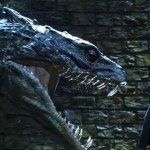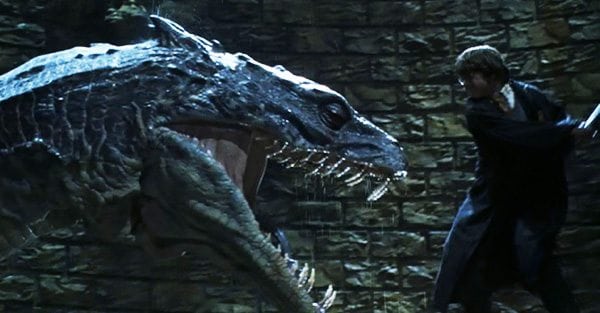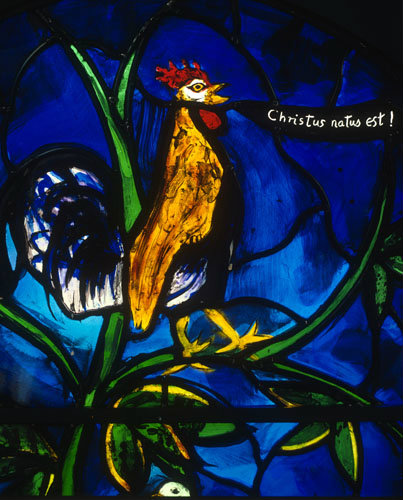Christmas in ‘Chamber of Secrets’: or, why is the crowing of the rooster fatal to the Basilisk? PART 2

Dec 24, 2019
News
How are you faring this holiday season, Potterheads? If you’re in need of some Harry Potter analysis to distract you from stress and holiday shopping traffic, we’ve got just the piece for you!
Last year, Dr Beatrice Groves (author of Literary Allusion in Harry Potter) helped us explore festive themes in the Harry Potter series, and this year we’re lucky enough to have her back to explain the connections between the roosters and Basilisk, and connections to Christmas in Harry Potter and the Chamber of Secrets.
Find Part 1 here, and settle in for the conclusion to another brilliant analysis of Christmas allusions in the Harry Potter series!
The Basilisk flees only from the crowing of the rooster, which is fatal to it. (Chamber, Chap 16, p.215)
As mentioned in Part 1 the Basilisk was identified with Satan in a number of bestiaries (including MS Bodley 764 which seems a plausible source for some of Rowling’s beast lore). And the rooster – the animal which Rowling (in common with a number of bestiaries) has chosen to defeat it – is likewise frequently identified with the divine. As Horatio reminds us in the beginning of Hamlet there is an obvious reason why the rooster should have the power to vanquish the powers of darkness: ‘The cock that is the trumpet to the morn,/ Doth with his lofty and shrill-sounding throat/ Awake the god of day’ (Hamlet, 1.1.149-51). In paganism the rooster is associated with Apollo; in Christianity it is likewise is emblematically the herald of Christ. In MS Bodley 764 this link between the cockerel and the light is moralised at length, and in Christian terms:
The crowing of the cock is a pleasant sound at night, and not only pleasant but useful, because, like a good neighbour, it wakes the sleeper, encourages the downhearted, and comforts the traveller, by charting the progress of the night with its melodious voice. When it crows, the robber leaves his ambush, the morning star itself awakes and lights the sky. The anxious sailor no longer fears for his life, and the storms which the winds of evenings arouse die down. The devout go to their prayers at cock-crow, and can read their books once more. When the cock crew thrice, the rock of the Church [St Peter] was cleansed of the guilt he had incurred by his denial of Christ before cock-crow. Its song brings hope back to everyone, eases the pain of the sick, cools the fevered brow, brings faith back to those who have lapsed. Jesus watches over those who stray, and brings the wanderers back to the path; He looked at Peter and his sin at once vanished and his denial was forgotten in the penitent recognition.[1]
The rooster and Jesus are paired here. The cock crow (Matthew 26.73-75), usually thought of as signalling St Peter’s guilt, here – in a redemption rereading – achieves the same cleansing of his soul as Jesus’ look does. Indeed, the cockerel is one of the few pieces of Christianised animal lore that still remain in common knowledge: most people recognise the weather-cock on church towers, even if they do not associate it symbolically with the herald of the daystar or a call to the faithful to remain vigilant.
There is, however, there is another reason why the call of the rooster might be considered to ward off the forces of darkness and, in particular, why Rowling might have drawn our attention to this idea at Christmas.
There is a very old legend that the night before Christmas, the animals were given the gift of speech in order to announce the birth of Christ. The earliest extant example of this idea is 4-5th century Latin poem by Prudentius which links the sounds animals make onomatopoeically with the meaning of their words: the sheep’s ‘In Betlem, Betlem’ (in Bethlehem, Bethlehem’), for example, sounding rather like a bleat. Traces of the legend can be found in Italy, Maderia and Switzerland as well as – particularly relevantly for Rowling – Portugal and France (for example in the French carol ‘Joie des Bestes’).[2]

The earliest British example of the legend is a late sixteenth century wall-panting (in Shuldbrede Priory on the Sussex/Surrey border) in which the animals announce the Nativity in Latin speech bubbles that echo the sounds of their calls. The rooster crows ‘Christus natus est’ (Christ is born), the goose asks ‘Quando, Quando?’ (when, when?), the crow replies in his harsh croak ‘in hac nocte’ (this night), the cow asks with its soft lowing ‘Ubi, ubi?’ (where, where?) and the lamb bleats ‘In Bethlem.’ In a Portuguese version the imitative sounde of the rooster’s cry is particularly clear ‘Jesus Christo êna…á…á…dó’[3] – but even the Latin version, ‘Christus natus est’ has precisely the same intonation as ‘cock-a-doodle-doo.’
There is also a seventeenth century version of the myth, published as ‘broadside’ (a popular poster-sized print). It was entitled ‘Christus natus est’ it was published in 1631 (and popular enough to be still being printed in 1701). It is an image of the Nativity, with animals behind Mary and Joseph with Latin speech bubbles, and an ‘explanation’ of what this Latin means:
The Cocke croweth,
Christus natus est;
Christ is borne.
The Rauen asked,
Quando?
When?
The Crow replied.
Hac nocte,
This night.
The Oxe cryed out,
Ubi? Ubi?
Where? Where?
The sheep bleated out,
Bethlem,
Bethlehem.
In modern times it is perhaps best known (and this is how I came to know of it) because of the beautiful John Piper window of the Nativity, designed in 1982 (and now a memorial to him in St Mary’s, Iffley, near Oxford).

[Above] Piper Window, Magdalen College, Oxford (Ken Barley, Flikr)
In Spain, Midnight Mass is still known as the Cockcrow Mass (Missa in Gallicantu) for this reason, and indeed it is the rooster which has always played the largest part in this myth. One nineteenth century collection of folk customs notes:
There are many superstitions connected with the coming of Christmas itself. To the cock have from time immemorial been attributed unwonted energy and sagacity at that season. Even now in England it is common to hear one say, when the cock crows in the stillness of the November and December nights, ‘The cock is crowing for Christmas’.[4]
There is, for example, an English ballad of ‘St Stephen and Herod’ which tells the related legend of the roasted cock which comes to life to cry out ‘Christus natus est.’ But the most famous place where the cock’s crow is related to Christmas – and with the particular power to vanquish dark spirits at that time – is Hamlet.
It is possible that Hamlet is set at Christmas, and it opens with the famous line ‘‘Tis bitter cold’ (1.1.6). Early in the play Marcellus tells of a specifically Christmas myth about the rooster. He notes that the ghost:
…faded on the crowing of the cock.
Some say that ever ‘gainst that season comes
Wherein our Saviour’s birth is celebrated
This bird of dawning singeth all night long;
And then, they say, no spirit dare stir abroad,
The nights are wholesome, then no planets strike,
No fairy takes, nor witch hath power to charm,
So hallow’d and so gracious is the time. (Hamlet, 1.1.162)
In Hamlet, bestiaries, carols and folk-tales the cockerel’s crow is associated with power over the spirits of darkness and the celebration of Christ’s birth. It is, therefore, beautifully fitting that the rooster’s crow should be fatal to the Basilisk, a creature of darkness, and that Rowling should leave a clue about this for us at Christmas.
We’d like to thank Beatrice for her thorough analysis of Christmas in Harry Potter, and for helping us get in the festive spirit! Read her analysis of carols in Harry Potter here, her analysis of the History of Magic exhibition here, her in-depth look at plant lore in Harry Potter, and be sure to check out Dr Groves’ book, Literary Allusion In Harry Potter, and follow her on Twitter!
REFERENCES:
[1] Richard W. Barber, trans., Bestiary: Being an English Version of the Bodleian Library, Oxford M. S. Bodley 764 with All the Original Miniatures Reproduced in Facsimile (London: Folio Society, 1992), pp.172-3.
[2] June Osborne, John Piper and Stained Glass (Stroud: Sutton Publishing, 1997), p.149.
[3] Arthur Ponsonby, The priory and manor of Lynchmere and Shulbrede (Taunton, 1930), p.14.
[4] William Shepard Walsh, Curiosities of Popular Customs, (London, 1897), p.232:



